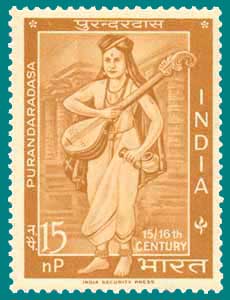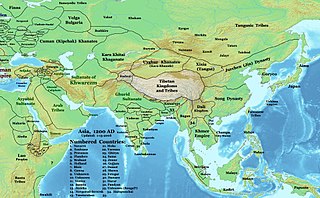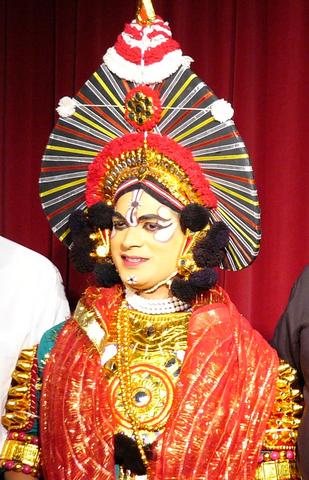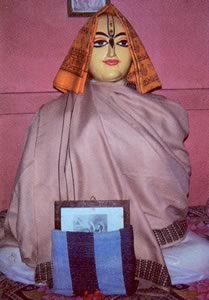Related Research Articles

The Bhakti movement was a significant religious movement in medieval Hinduism that sought to bring religious reforms to all strata of society by adopting the method of devotion to achieve salvation. Originating in Tamilakam during 6th century CE, it gained prominence through the poems and teachings of the Vaishnava Alvars and Shaiva Nayanars before spreading northwards. It swept over east and north India from the 15th century onwards, reaching its zenith between the 15th and 17th century CE.
The Kannadigas or Kannaḍigaru, often referred to as Kannada people, are a Dravidian ethno-linguistic group who natively speak Kannada and trace their ancestry to the South Indian state of Karnataka in India and its surrounding regions. The Kannada language belongs to the Dravidian family of languages. Kannada stands among 30 of the most widely spoken languages of the world as of 2001.

Srinivasa Nayaka,also popularly known as Purandara Dasa was a composer, singer and a Haridasa philosopher from present-day Karnataka, India. He was a follower of Madhvacharya's Dvaita philosophy. He was one of the chief founding proponents of Carnatic music. In honor of his significant contributions to Carnatic music, he is widely referred to as the Pitamaha of Carnatic music. According to a legend, he is considered as an incarnation of Narada.
Kannada (ಕನ್ನಡ) is the language spoken in Karnataka. Karnataka has eight Jnanapeeth award winners, the highest honor bestowed for Indian literature. From the period of Adikavi Pampa(ಆದಿಕವಿ ಪಂಪ) who proclaimed his wish to be reborn as a little bee in the land of Kannada, Kannada poetry has come a long way to Kuvempu (ಕುವೆಂಪು) and Dattatreya Ramachandra Bendre
Dasa Sahitya is a genre of literature of bhakti movement composed by devotees in honor of Vishnu or one of his avatars. Dasa is literally servant in Kannada and sahitya is literature. Haridasas were preachers of bhakti to Vishnu or one of his avatars. The bhakti literature of these Haridasas is collectively referred to as Dasa Sahitya. It is in the Kannada language. Dasas are Dvaita scholars and poets.

Kanaka Dasa (1509–1609) was a Haridasa saint and philosopher of Dvaita Vedanta, popularly called Daasashreshta Kanakadasa from present-day Karnataka, India. He was a follower of Madhvacharya's Dvaita philosophy and a disciple of Vyasatirtha. He was a renowned composer of Carnatic music, poet, reformer and musician. He is known for his keertanas and ugabhoga, and his compositions in the Kannada language for Carnatic music. Like other Haridasas, he used simple Kannada and native metrical forms for his compositions.

Karnataka is a state of India with a long tradition of innovation in the fields of both Carnatic and Hindustani classical music.
The migrations of people and influences to the North from Karnataka during 7th-12th century period is well attested by the sources but has not yet been studied carefully. This is known as "The Great Karnataka expansion"

The Haridasa Bhakti Sahitya devotional movement (sampradaya) originated in Karnataka, India, after Madhvacharya, and spread to eastern states such as Bengal and Assam of medieval India. Over a span of nearly six centuries, several saints and mystics helped shape the culture, philosophy and art of South India in general and Karnataka in particular by exerting considerable spiritual influence over the masses and kingdoms that ruled South India.

Hoysala literature is the large body of literature in the Kannada and Sanskrit languages produced by the Hoysala Empire (1025–1343) in what is now southern India. The empire was established by Nripa Kama II, came into political prominence during the rule of King Vishnuvardhana (1108–1152), and declined gradually after its defeat by the Khalji dynasty invaders in 1311.
Vyasakuta was one of two divisions of Haridasas, a group within the Bhakti movement, one of the monotheistic Hindu religious devotional movements focusing on the spiritual practice of loving devotion to a God, called bhakti. This generally means the worship of Lord Vishnu

Karnataka, a southern state in India, has a distinct art style and culture informed by a long history of diverse linguistic and religious ethnicities. Apart from Kannadigas, Karnataka is home to Tuluvas, who also consider themselves as Kannadigas. Minor populations of Tibetan Buddhists, Siddhi tribes, and a few other ethnic groups also live in Karnataka. The traditional folk arts are major theatrical forms in coastal Karnataka. Contemporary theatre culture in Karnataka is one of the most vibrant in India, with organizations like Ninasam, Ranga Shankara, and Rangayana on foundations laid by the Gubbi Veeranna Nataka Company. Veeragase, Kamsale, and Dollu Kunitha are popular dance forms. Bharatanatya also enjoys wide patronage in Karnataka.

Vijaya Dasa was a prominent saint from the Haridasa tradition of Karnataka, India in the 18th century, and a scholar of the Dvaita philosophical tradition. Along with contemporary haridasa saints such as Gopala Dasa, Helevankatte Giriamma, Jagannatha Dasa and Prasanna Venkata Dasa, he propagated the virtues of the philosophy of Madhwacharya across South India through devotional songs called devaranama written in the Kannada language. An integral part of Kannada Vaishnava devotional literature, these compositions in praise of the Hindu god Vishnu as well as other deities are called dasara padagalu. He has influenced both Carnatic music and Hindustani music through his compositions. His ankita is Vijaya vithala. These compositions can be more specifically categorized as keertanas, suladis, ugabhogas, and simply padas. They were easy to sing to the accompaniment of a musical instrument and dealt with bhakti (devotion) and the virtues of a pious life.
Medieval Kannada literature covered a wide range of subjects and genres which can broadly be classified under the Jain, Virashaiva, Vaishnava and secular traditions. These include writings from the 7th century rise of the Badami Chalukya empire to the 16th century, coinciding with the decline of Vijayanagara Empire. The earliest known literary works until about the 12th century CE were mostly authored by the Jainas along with a few works by Virashaivas and Brahmins and hence this period is called the age of Jain literature,. The 13th century CE, to the 15th century CE, saw the emergence of numerous Virashaiva and Brahminical writers with a proportional decline in Jain literary works. Thereafter, Virashaiva and Brahmin writers have dominated the Kannada literary tradition. Some of the earliest metres used by Jain writers prior to 9th century include the chattana, bedande and the melvadu metres, writings in which have not been discovered but are known from references made to them in later centuries. Popular metres from the 9th century onwards when Kannada literature is available are the champu-kavyas or just champu, vachanasangatya, shatpadi, ragale, tripadi, and kavya.

Mysore literature in Kannada is a body of literature composed in the Kannada language in the historical Kingdom of Mysore in Southern India and written in the Kannada script. The writings date from the Kingdom of Mysore, which existed from around 1600 CE until the establishment of modern India in 1947. Many of the works of this literature written on religious themes are labeled Veerashaiva or Vaishnava in acknowledgment of the two faiths that gave form to the literature and fostered it until the advent of the modern era. Despite a gradual decline in the popularity of Jainism, authors devoted to the faith produced some works of merit. Secular themes dealing with a wide range of subjects were also written on. Kannada literature flourished for a short while in the court of the neighbouring kingdom of the Nayakas of Keladi whose territory was annexed by Mysore in 1763.

Gopala Dasa (1721–1769) was a prominent 18th-century Kannada language poet and saint belonging to the Haridasa tradition. With other contemporary Haridasas such as Vijaya Dasa and Jagannatha Dasa, Gopala Dasa propagated the Dvaita philosophy of Madhvacharya in South India through Kirtans known as Dasara Padagalu with the pen-name "Gopala Vittala".He is Ganesa Amsha.

Vijayanagara literature in Kannada is the body of literature composed in the Kannada language of South India during the ascendancy of the Vijayanagara Empire which lasted from the 14th through the 16th century. The Vijayanagara empire was established in 1336 by Harihara I and his brother Bukka Raya I. Although it lasted until 1664, its power declined after a major military defeat by the Shahi Sultanates in the battle of Talikota in 1565. The empire is named after its capital city Vijayanagara, whose ruins surround modern Hampi, now a World Heritage Site in Karnataka.

Haridasa Thakur was a prominent Vaishnava saint known for being instrumental in the initial propagation of the Hare Krishna movement. He is considered to be the most famous convert of Chaitanya Mahaprabhu, apart from Rupa Goswami and Sanatana Goswami. His story of integrity and unflinching faith in the face of extreme adversity is told in Chaitanya Charitamrita, Antya lila. It is believed that Chaitanya Mahaprabhu himself designated Haridasa as nāmācarya, meaning the 'teacher of the Name'. Haridasa Thakura was a devotee of the deity Krishna, and is regarded to have practised the chant of his veneration, Hare Krishna, 300,000 times daily.

Jagannatha Dasa (1728–1809), a native of Manvi town in the Raichur district, Karnataka state, India, comes in the preceptorial line of Madhvacharya and is considered one of the notable Haridasa of Dvaita Vedanta of Madhva saint-poets of the Kannada language.

Hinduism is the most followed Religion in India and nearly 84% of the total population of Karnataka follows Hinduism, as per 2011 Census of India. Several great empires and dynasties have ruled over Karnataka and many of them have contributed richly to the growth of Hinduism, its temple culture and social development. These developments have reinforced the "Householder tradition", which is of disciplined domesticity, though the saints who propagated Hinduism in the state and in the country were themselves ascetics. The Bhakti movement, of Hindu origin, is devoted to the worship of Shiva and Vishnu; it had a telling impact on the sociocultural ethos of Karnataka from the 12th century onwards.
References
- Jagadeesan, N The Life and Mission of Karaikkal Ammaiyar Bhattacharya, N.N. [ed] Medieval Bhakti Movements in India Munishiram Manoharlal, New Delhi, (1989), pages 149-161